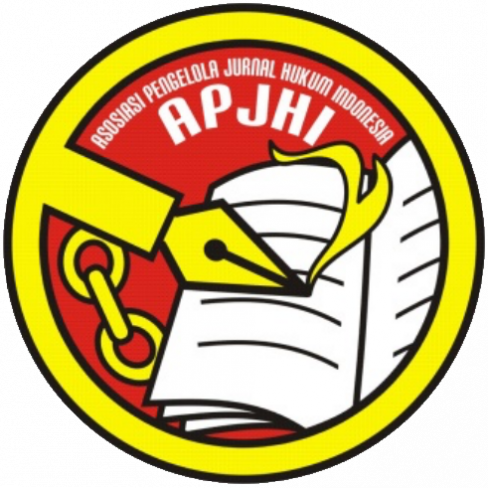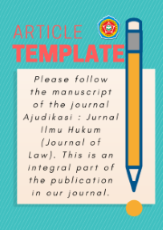The Effect of Restorative Justice for Drug Users on The Overcapacity of Correctional Facility in Solo City
DOI:
https://doi.org/10.30656/ajudikasi.v8i1.8399Keywords:
Restorative, Justice, DrugsAbstract
The problem of drug abuse has become a major challenge in many countries, causing the number of prisoners addicted to narcotics to increase and causing overcrowding in prisons. This article discusses the influence of restorative justice as an innovative solution in dealing with drug users and overcrowding in correctional facility. Restorative justice replaces the traditional punishment-focused approach with one that is oriented towards rehabilitation, reconciliation, and the active participation of drug users in the rehabilitation process. In addition, restorative justice can help reduce overcrowding in prisons by reassessing the detention approach to drug users. Alternatives such as community-based rehabilitation programs and electronic monitoring could be implemented to alleviate pressure on the overcrowded prison system. By combining restorative justice and prison reform, governments can create more sustainable and humane solutions to the complex challenges of drug addiction.
Downloads
References
Almond, Mustaqim, and Eva Achjani Zulfa. “Optimalisasi Pendekatan Restorative Justice Terhadap Victimless Crime (Penyalahgunaan Narkoba) Sebagai Solusi Lapas Yang Over Kapasitas.†Jurnal Pendidikan Tambusai 6, no. 1 SE-Articles of Research (2022): 8198–8206. https://jptam.org/index.php/jptam/article/view/3684.
Anam, M Khoirul. “Badan Narkotika Nasional Kota Mojokerto,†2022, 13–26.
Arifin, Alif Wisuda, Pujiyono, and Nur Rochaeti. “Implementasi Konsep Restorative Justice Sebagai Upaya Menanggulangi Overcapacity Narapidana Di Lembaga Pemasyarakatan Kelas I Semarang.†Diponegoro Law Journal 11, no. 1 (2021): 361–416.
Chandra, Tofik Yanuar, Joko Sriwidodo, and M.S. Tumanggor. “Rehabilitation of Narcotic Addictives: An Overview of Implementation and The Effort by Restorative Justice.†Krtha Bhayangkara 17, no. 3 (2023): 465–80. https://doi.org/10.31599/krtha.v17i3.2427.
Cok Satrya Aditya, and Ani Purwanti. “Implementation of Sanctions against Addictive and Narcotic Abuse Perspective Restorative Justice.†Polit Journal Scientific Journal of Politics 3, no. 1 (2023): 32–37. https://doi.org/10.33258/polit.v3i1.847.
Dwita, Anindya, and Mohammad Zamroni. “Jurnal Hukum Dan Etika Kesehatan.†Jurnal Hukum Dan Etika Kesehatan 1, no. September (2021): 46–64.
Hukum, Fakultas, Universitas Lampung, and Bandar Lampung. “E-ISSN: 2598-3105 P-ISSN:2723-2581 Http://Jurnal.Fh.Unila.Ac.Id/Index.Php/Cepalo†6, no. 1 (2022): 74–85. https://doi.org/10.2648/cepalo.v6no1.
Indriawati, Sri. “Politics of Criminal Law in Implementing Restorative Justice Against Narcotics Addicts in the Criminal Justice System,†2022. https://doi.org/10.4108/eai.16-4-2022.2320131.
Karim, Khalid, Victoria Tischler, Peter Gregory, and Panos Vostanis. “International Journal of Social HEALTH OUTCOME†2, no. 3 (2006): 112–16.
Maiza, Putri. “The Effort to Reduce Over Capacity in Correctional Facilities through Social Work Alternative Punishment.†Ius Poenale 2, no. 2 (2022): 1.
Marliani, Siagian, Miftahudin. “Dampak Over Crowded Terhadap Gangguan Keamanan Dan Ketertiban Di Lembaga Permasyarakatan (Study Case Lapas Narkotika Kelas II A Jakarta).†Jurnal Pendidikan Dan Konseling 4, no. 6 (2022): 79. https://core.ac.uk/download/pdf/322599509.pdf.
Pangestu, Yoga, and Mitro Subroto. “Pengaruh Pemberian Asimilasi Di Rumah Terhadap Penekanan Angka Overkapasitas Di Lembaga Pemasyarakatan Yoga.†Jurnal JPDK UniVersitas Pahlawan 4 (2022): 2018–23. http://journal.universitaspahlawan.ac.id/index.php/jpdk/article/view/4074.
Pratama, F M, and S N Maulidna. “Reformasi Sistem Penjara Untuk Mengatasi Overkapasitas Rumah Tahanan: Tinjauan Dari Sudut Pandang Hukum Nasional:(Studi Kasus Rumah Tahanan Kebon ….†Doktrin: Jurnal Dunia Ilmu … 1, no. 4 (2023). https://journal.widyakarya.ac.id/index.php/Doktrin-widyakarya/article/view/1467%0Ahttps://journal.widyakarya.ac.id/index.php/Doktrin-widyakarya/article/download/1467/1502.
Roswari, Bunga, Sukmareni, and Syaiful Munandar. “Penerapan Restorative Justice Oleh Kejaksaan Negeri Pasaman Teradap Pelaku Tindak Pidana Penyalahgunaan Narkotika.†UNES Law Review 6, no. 1 (2023): 953–65. https://review-unes.com/index.php/law/article/view/772.
Saputra, Satria Nenda Eka, and Muridah Isnawati. “Overcrowding Lembaga Pemasyarakatan (Lapas) Dalam System Pemidanaan Di Indonesia.†Pagaruyuang Law Journal 6, no. 1 (2022): 52–70. https://doi.org/10.31869/plj.v0i0.3822.
Sidabutar, Ronny Nicolas, and Alvi Syahrin. “Penyelesaian Perkara Narkotika Bagi Penyalahguna Sebagai Korban Dengan Pendekatan Keadilan Restoratif Dalam Kajian Norma Keadilan Berdasarkan Pancasila.†Jurnal Hukum Kaidah: Media Komunikasi Dan Informasi Dan Masyarakat 23, no. 1 (2022): 10–25.
Sitanggang, Darsono, Lagat Parroha Patar Siadari, and Dahlan Dahlan. “Juridical Analysis of The Application of Restorative Justice in Case of Narcotics Abuse in The Directorate of Drugs, Polda Kepri.†International Journal of Educational Review, Law And Social Sciences (IJERLAS) 3, no. 1 (2023): 1–10. http://radjapublika.com/index.php/IJERLAS/article/view/479.
Sulaiman, Anwar, and Asmak Hosnah. “Analisis Penerapan Restorative Justice Dalam Kasus Tindak Pidana Ringan Sebagai Upaya Mengurangi Over Kapasitas Di Lembaga Pemasyarakatan.†Internasional Journal of Socioology, Policy and Law (IJOSPL) 3, no. 2 (2022): 57–67.
Usman, Usman, Bahder Johan Nasution, and Elizabeth Seregar. “Over Kapasitas Lembaga Pemasyarakatan Dalam Perespektif Kebijakan Hukum Pidana.†Wajah Hukum 4, no. 2 (2020): 436. https://doi.org/10.33087/wjh.v4i2.256.
Yulianti, Wulan Dwi. “Upaya Menanggulangi Over Kapasitas Pada Lembaga Pemasyarakatan Di Indonesia.†Al-Qisthu: Jurnal Kajian Ilmu-Ilmu Hukum 18, no. 2 (2020): 61–66. https://doi.org/10.32694/010980.
Downloads
Published
Issue
Section
License
Authors who publish with this journal agree to the following terms:
Authors retain copyright and grant the journal right of first publication with the work simultaneously licensed under a Creative Commons Attribution License that allows others to share the work with an acknowledgment of the work's authorship and initial publication in this journal.
Authors can enter into separate, additional contractual arrangements for the non-exclusive distribution of the journal's published version of the work (e.g., post it to an institutional repository or publish it in a book) with an acknowledgment of its initial publication in this journal.
Authors are permitted and encouraged to post their work online (e.g., in institutional repositories or on their website) before and during the submission process, as it can lead to productive exchanges and earlier and greater citation of published work.
All articles in Ajudikasi : Jurnal Ilmu Hukum can be disseminated provided they include the identity of the article and the source of the article (Ajudikasi : Jurnal Ilmu Hukum). The publisher is not responsible for the contents of the article. The content of the article is the sole responsibility of the author
Ajudikasi : Jurnal Ilmu Hukum is lincensed under a Creative Commons Attribution-ShareAlike 4.0 International License.









1.png)
.png)
.png)





.png)
.png)
.png)
.png)





.png)







